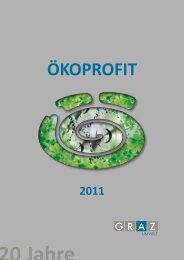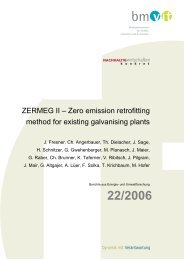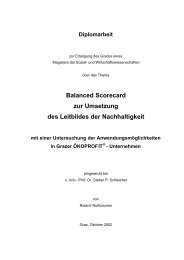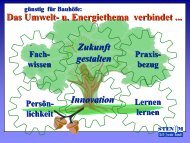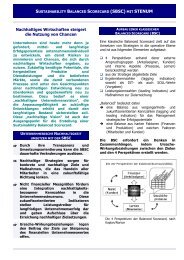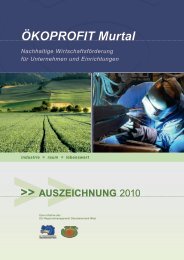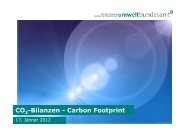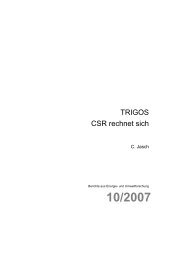Promoting Resource Efficiency in Small & Medium size ... - UNEP
Promoting Resource Efficiency in Small & Medium size ... - UNEP
Promoting Resource Efficiency in Small & Medium size ... - UNEP
Create successful ePaper yourself
Turn your PDF publications into a flip-book with our unique Google optimized e-Paper software.
ignited by a high energy source. It can decompose at high temperatures<br />
form<strong>in</strong>g toxic gases such as hydrogen chloride, chlor<strong>in</strong>e and phosgene.<br />
Closed conta<strong>in</strong>ers may rupture and explode if heated. Trichloroethylene<br />
vapours may accumulate <strong>in</strong> low-ly<strong>in</strong>g areas. The vapour causes irritation<br />
of the nose and throat. Trichloroethylene is also a central nervous<br />
system depressant. The vapour may cause headache, nausea, dizz<strong>in</strong>ess,<br />
drows<strong>in</strong>ess, <strong>in</strong>coord<strong>in</strong>ation and confusion. High vapour concentrations<br />
may cause unconsciousness and death. Trichloroethylene causes sk<strong>in</strong><br />
and eye irritation and it is an aspiration hazard. Swallow<strong>in</strong>g or vomit<strong>in</strong>g<br />
of the liquid may result <strong>in</strong> aspiration (breath<strong>in</strong>g) <strong>in</strong>to the lungs.<br />
Trichloroethylene is a suspect cancer hazard, which may cause cancer<br />
based on human <strong>in</strong>formation, and a possible reproductive hazard that<br />
may cause birth defects, based on animal <strong>in</strong>formation, and a mutagen<br />
that may cause genetic damage, based on animal <strong>in</strong>formation.<br />
Trichloroethylene is predom<strong>in</strong>antly used for vapour degreas<strong>in</strong>g of<br />
metal parts <strong>in</strong> the automotive and metal <strong>in</strong>dustries. It is also used as a<br />
component of adhesives and as a solvent <strong>in</strong> pa<strong>in</strong>t-strippers, lubricants,<br />
pa<strong>in</strong>ts, varnishes, pesticides, cold metal cleaners, rubbers and elastomers.<br />
It is used as a low temperature heat-transfer medium and as a chemical<br />
<strong>in</strong>termediate <strong>in</strong> the production of pharmaceuticals, flame retardant<br />
chemicals and <strong>in</strong>secticides. It is used <strong>in</strong> metal phosphatis<strong>in</strong>g systems,<br />
textile process<strong>in</strong>g, the production of polyv<strong>in</strong>yl chloride and aerospace<br />
operations. 77<br />
Short-term exposure to trichloroethylene causes irritation of the nose and<br />
throat and central nervous system (CNS) depression, with symptoms<br />
such as drows<strong>in</strong>ess, dizz<strong>in</strong>ess, gidd<strong>in</strong>ess, headache, loss of coord<strong>in</strong>ation.<br />
High concentrations have caused numbness and facial pa<strong>in</strong>, reduced<br />
eyesight, unconsciousness, irregular heartbeat and death. 78<br />
The effect of refrigerants with high ODP<br />
The environmental friendl<strong>in</strong>ess of a refrigerant is a major factor <strong>in</strong><br />
assess<strong>in</strong>g the usefulness of a particular refrigerant. The important<br />
environmental and safety properties are:<br />
Ozone Depletion Potential (ODP): The ODP of refrigerants should be<br />
zero, i.e., they should be non-ozone deplet<strong>in</strong>g substances. Refrigerants<br />
hav<strong>in</strong>g non-zero ODP have either already been phased-out (e.g. R 11,<br />
R 12) or will be phased-out <strong>in</strong> the near future (e.g. R 22). S<strong>in</strong>ce ODP<br />
depends ma<strong>in</strong>ly on the presence of chlor<strong>in</strong>e or brom<strong>in</strong>e <strong>in</strong> the molecules,<br />
refrigerants hav<strong>in</strong>g either chlor<strong>in</strong>e (i.e. CFCs and HCFCs) or brom<strong>in</strong>e<br />
cannot be used under the new regulations.<br />
Other important environmental and safety properties:<br />
• Global Warm<strong>in</strong>g Potential (GWP)<br />
• Total Equivalent Warm<strong>in</strong>g Index (TEWI)<br />
• Toxicity<br />
• Flammability<br />
Refrigerant<br />
R 11 (CFC)<br />
ODP = 1.0<br />
GWP = 3500<br />
R 12 (CFC)<br />
ODP = 1.0<br />
GWP = 7300<br />
R 22 (HCFC)<br />
ODP = 0.05<br />
GWP = 1500<br />
R 134a (HFC)<br />
ODP = 0.0<br />
GWP = 1200<br />
Application<br />
Large air condition<strong>in</strong>g systems<br />
Industrial heat pumps<br />
As foam blow<strong>in</strong>g agent<br />
Domestic refrigerators<br />
<strong>Small</strong> air conditioners<br />
Water coolers<br />
<strong>Small</strong> cold storages<br />
Air condition<strong>in</strong>g systems<br />
Cold storages<br />
Used as replacement for R 12 <strong>in</strong> domestic refrigerators,<br />
water coolers, automobile A/Cs etc.<br />
Substitute suggested<br />
Retrofit ( R )/New (N)<br />
R 123 (R,N)<br />
R 22 (R,N)<br />
R 134a (R,N)<br />
R 227ea (N)<br />
R 401A, R 401B (R,N)<br />
R 411A, R411B (R,N)<br />
R 717 (N)<br />
R 410A, R 410B (N)<br />
R 417A (R,N)<br />
R 407C (R,N)<br />
R 507, R507A (R,N)<br />
R 404A (R,N)<br />
R 717 (N)<br />
No replacement required<br />
- Immiscible <strong>in</strong> m<strong>in</strong>eral oils<br />
- Highly hygroscopic<br />
R 717 (NH 3<br />
)<br />
ODP = 0.0<br />
GWP = 0.0<br />
R 744 (CO 2 )<br />
ODP = 0.0<br />
GWP = 1.0<br />
R 718 (H 2 O)<br />
ODP = 0.0<br />
GWP = 1.0<br />
R 600a (iso-butane)<br />
ODP = 0.0<br />
GWP = 3.0<br />
Cold storages<br />
Ice plants<br />
Food process<strong>in</strong>g<br />
Frozen food cab<strong>in</strong>ets<br />
Cold storages<br />
Air condition<strong>in</strong>g systems<br />
Simultaneous cool<strong>in</strong>g and heat<strong>in</strong>g (Transcritical cycle)<br />
Absorption systems<br />
Steam jet systems<br />
Replacement for R 12<br />
Domestic refrigerators<br />
Water coolers<br />
No replacement required<br />
- Toxic and flammable<br />
- Incompatible with copper<br />
- Highly efficient<br />
- Inexpensive and available<br />
No replacement required<br />
- Very low critical temperature<br />
- Inexpensive and available<br />
No replacement required<br />
- High freez<strong>in</strong>g po<strong>in</strong>t<br />
- Large specific volume<br />
- Inexpensive and available<br />
No replacement required<br />
- Flammable<br />
Table 18: Applications of common refrigerants and suggested substitutes 79<br />
77) Canadian Centre for Occupational Health and Safety, Trichlorethylene, 1999.<br />
78) Canadian Centre for Occupational Health and Safety, Health effects of Trichloethylene, 1999.<br />
79) Scribd, 26 Refrigerants, undated<br />
75




